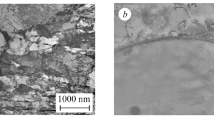Conclusions
-
1.
It was shown that intensive reactor irradiation, within the investigated intervals of the initial parameters of the experiments, substantially changes the limiting state of steel 0Kh16N15M3B. It lowers time-to-rupture by roughly two orders. The level of the radiative reduction in time-to-rupture increases with a decrease in stress.
-
2.
Given the parameter values investigated, reactor irradiation does not alter the type of functional relationship between time-to-rupture and stress. The above-noted reduction in time-to-rupture evidently occurs only as a result of an increasein the intensity of the fracture process.
-
3.
In studying the limiting state of structural materials and obtaining correct results on the correspondence between the rupture strength of the materials and different criteria, it is necessary to consider the grain size of the original structure.
-
4.
Within the investigated range of parameter values in experiments with a fixed grain size, the investigated rupture-strength criteria cannot be used in tests under normal conditions. In the case of reactor irradiation, the von Mises and Pisarenko-Lebedev criteria may be used as first approximations.
Similar content being viewed by others
Literature cited
Yu. I. Likhachev and V. Ya. Pupko, Strength of Nuclear Reactor Fuel Elements [in Russian], Atomizdat, Moscow (1975).
V. A. Tsykanov and E. F. Davydov, Radiation Resistance of Nuclear Reactor Fuel Elements [in Russian], Atomizdat, Moscow (1977).
V. P. Gol'tsev, A. Ya. Kamenev, A. I. Rytvinskii, and E. E. Fedyushin, Structural Materials of an Atomic Power Plant with a Dissociating N2O4 Coolant [in Russian], Nauka i Tekhnika, Minsk (1976).
A. M. Parshin, The Structure, Strength, and Ductility of Stainless Steels and Alloys Used in Shipbuilding [in Russian], Sudostroenie, Leningrad (1972).
G. S. Pisarenko, V. N. Kiselevskii, D. V. Polevoi, et al., “Effect of reactor irradiation on the creep resistance and rupture strength of austenitic stainless steel 0Kh16N15M3B,” Probl. Prochn., No. 4, 3–8 (1974).
V. N. Kiselevskii, V. K. Lukashev, D. V. Polevoi, et al., “Effect of reactor irradiation on the rupture strength of steel Kh16N15M3B in relation to the type of stress state,” Probl. Prochn., No. 9, 39–42 (1974).
S. N. Votinov, N. P. Losev, V. I. Prokhorov, et al., “Evaluating the in-pile rupture strength of structural materials,” Probl. Prochn., No. 5, 61–64 (1971).
A. G. Fin'ko, Method and Certain Results of Radiation Tests of Fuel-Element Jackets, Summary of Documents of the Ail-Union School on In-Pile Test Methods, Dimitrovgrad (1978), pp. 159–168.
N. V. Markina and B. V. Samsonov, Temperature Measurement in the Irradiation of Materials, Preprint NIIAR P-152, Melekess (1972).
N. V. Markina, “Features of temperature measurement in nuclear reactors with a high flux density,” Author's Abstract of Candidate's Dissertation, Engineering Sciences, Dimitrovgrad (1974).
G. S. Pisarenko, V. K. Lukashev, V. N. Kiselevskii, and D. V. Polevoi, “Unit for studying the strength of complex-stressed materials in a reactor radiation field,” Termoprochn. Mater. Konstr. Elem., No. 5, 390–394 (1969).
V. N. Kiselevskii, V. K. Lukashev, and G. P. Khristov, “Modernized unit for in-pile creep and stress rupture tests of materials in a complex stress state,” Probl. Prochn., No. 4, 122–124 (1977).
G. P. Khristov, S. N. Sushkov, and D. F. Kharitonov, “Machine for creep tests under conditions of a complex stress state,” Zavod. Lab.,44, No. 11, 1398–1400 (1978).
G. P. Khristov, N. P. Losev, and B. A. Samigullin, “‘Neitron-M2’ loading device for in-pile creep and stress rupture tests of tubular specimens in a plane stress state,” Probl. Prochn., No. 9, 122–126 (1980).
D. I. Morris, “Creep failure in type 316 austenitic steel,” Met. Sci.,12, No. 1, 19–29 (1978).
G. P. Mel'nikov, Rupture Time of Structural Elements in High-Temperature Stand Tests [in Russian], Atomizdat, Moscow (1978).
G. S. Pisarenko and A. A. Lebedev, Deformation and Strength of Materials in a Complex Stress State [in Russian], Naukova Dumka, Kiev (1976).
M. N. Stepnov, Statistical Analysis of Mechanical Test Results [in Russian], Mashinostroenie, Moscow (1972).
M. Kendall and A. Stuart, Statistical Conclusions and Relations [Russian translation], Nauka, Moscow (1973).
G. G. Abezgauz, A. P. Tron', Yu. N. Kopenkin, and I. A. Korovina, Handbook of Probability Calculation [in Russian], Voenizdat, Moscow (1970).
Author information
Authors and Affiliations
Additional information
Translated from Problemy Prochnosti, No. 7, pp. 77–84, July, 1981.
Rights and permissions
About this article
Cite this article
Khristov, G.P., Lukashev, V.K., Kosov, B.D. et al. Effect of reactor irradiation on the rupture strength and creep of steel 0Kh16N15M3B in plane stress. Report no. 1. Strength Mater 13, 895–901 (1981). https://doi.org/10.1007/BF00767313
Received:
Issue Date:
DOI: https://doi.org/10.1007/BF00767313



